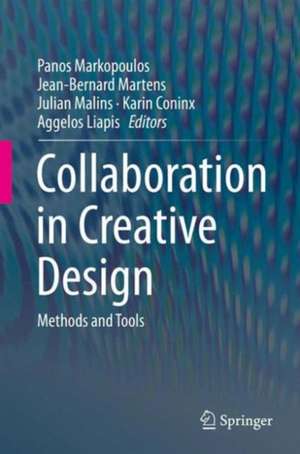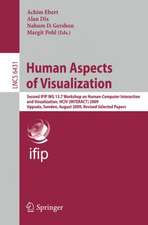Collaboration in Creative Design: Methods and Tools
Editat de Panos Markopoulos, Jean-Bernard Martens, Julian Malins, Karin Coninx, Aggelos Liapisen Limba Engleză Hardback – 23 mai 2016
A wide range of design approaches are explored, some emphasizing on the physicality of interaction and the products designed, others exploring interactive design and the emerging user experience (UX) with a focus on the value to the end-user. Contemporary design processes and the role of software tools to support design are also discussed. The researchers draw their expertise from a wide range of fields and it is this interdisciplinary approach which provides a unique perspective resulting in a flexible collection of methods that can be applied to a wide range of design contexts.
Interaction and UX designers andproduct design specialists will all find Collaboration in Creative Design an essential read.
| Toate formatele și edițiile | Preț | Express |
|---|---|---|
| Paperback (1) | 604.41 lei 38-44 zile | |
| Springer International Publishing – 27 mai 2018 | 604.41 lei 38-44 zile | |
| Hardback (1) | 627.93 lei 38-44 zile | |
| Springer International Publishing – 23 mai 2016 | 627.93 lei 38-44 zile |
Preț: 627.93 lei
Preț vechi: 784.92 lei
-20% Nou
Puncte Express: 942
Preț estimativ în valută:
120.17€ • 124.70$ • 100.44£
120.17€ • 124.70$ • 100.44£
Carte tipărită la comandă
Livrare economică 11-17 martie
Preluare comenzi: 021 569.72.76
Specificații
ISBN-13: 9783319291536
ISBN-10: 331929153X
Pagini: 415
Ilustrații: IX, 393 p. 150 illus., 100 illus. in color.
Dimensiuni: 155 x 235 x 27 mm
Greutate: 0.91 kg
Ediția:1st ed. 2016
Editura: Springer International Publishing
Colecția Springer
Locul publicării:Cham, Switzerland
ISBN-10: 331929153X
Pagini: 415
Ilustrații: IX, 393 p. 150 illus., 100 illus. in color.
Dimensiuni: 155 x 235 x 27 mm
Greutate: 0.91 kg
Ediția:1st ed. 2016
Editura: Springer International Publishing
Colecția Springer
Locul publicării:Cham, Switzerland
Public țintă
ResearchCuprins
Creativity and Collaboration in Early Design.- Part I: Discovery.- Two Heads Are Better Than One: Principles and Tools for Collaborative Design Practice.- Probing - Two Perspectives to Participation.- Supporting Early Design through Conjoint Trends Analysis Methods and the TRENDS System.- Part II: Generating Ideas & Concepts.- Designing with Cards.- Combining User Needs and Stakeholder Requirements: The Value Design Method.- Crowdsourcing User and Design Research.- Cardboard Modelling: Exploring, Experiencing and Communicating.- Part III: Designing with Stories.- STORYPLY: Designing for User Experiences using Storycraft.- Storyboards as a Lingua Franca in Multidisciplinary Design Teams.- Co-Constructing New Concept Stories with Users.- idAnimate: Supporting Conceptual Design with Animation-Sketching.- Using Video for Early Interaction Design.- Part IV: Tools for Creativity and Collaboration in Early Design.-Early Stage Creative Design Collaboration: A Survey of Current Practices.- Using the Bright Sparks Software Tool During Creative Design Work.- From the Real to the Virtual: Developing Better Software Applications Using Design Thinking.- Design and Data: Strategies for Designing Information Products in Team Settings.- Decrypting the IT Needs of the Designer During the Creative Stages of the Design Process.
Normal 0 false false false EN-GB X-NONE X-NONE /*Style Definitions */ table.MsoNormalTable {mso-style-name:"Table Normal"; mso-tstyle-rowband-size:0; mso-tstyle-colband-size:0; mso-style-noshow:yes; mso-style-priority:99; mso-style-parent:""; mso-padding-alt:0cm 5.4pt 0cm 5.4pt; mso-para-margin-top:0cm; mso-para-margin-right:0cm; mso-para-margin-bottom:10.0pt; mso-para-margin-left:0cm; line-height:115%; mso-pagination:widow-orphan; font-size:11.0pt; font-family:"Calibri","sans-serif"; mso-ascii-font-family:Calibri; mso-ascii-theme-font:minor-latin; mso-hansi-font-family:Calibri; mso-hansi-theme-font:minor-latin; mso-fareast-language:EN-US;}
Textul de pe ultima copertă
This book presents a number of new methods, tools, and approaches aimed to assist researchers and designers during the early stages of the design process, focusing on the need to approach the development of new interactive products, systems and related services by closely observing the needs of potential end-users through adopting a design thinking approach.
A wide range of design approaches are explored, some emphasizing on the physicality of interaction and the products designed, others exploring interactive design and the emerging user experience (UX) with a focus on the value to the end-user. Contemporary design processes and the role of software tools to support design are also discussed. The researchers draw their expertise from a wide range of fields and it is this interdisciplinary approach which provides a unique perspective resulting in a flexible collection of methods that can be applied to a very wide range of design contexts.
Interaction and UX designers and product design specialists will all find Collaboration in Creative Design an essential read.
A wide range of design approaches are explored, some emphasizing on the physicality of interaction and the products designed, others exploring interactive design and the emerging user experience (UX) with a focus on the value to the end-user. Contemporary design processes and the role of software tools to support design are also discussed. The researchers draw their expertise from a wide range of fields and it is this interdisciplinary approach which provides a unique perspective resulting in a flexible collection of methods that can be applied to a very wide range of design contexts.
Interaction and UX designers and product design specialists will all find Collaboration in Creative Design an essential read.
Caracteristici
Explores new methods and tools for identifying new opportunities, prototyping and evaluating new applications Presents how creative design and collaborative working is leading to more effective ways of developing new products and services by using a range of creative methods and tools Provides a detailed ‘how to’ guide with several methods, examples and exercises, and guidance for further reading



























